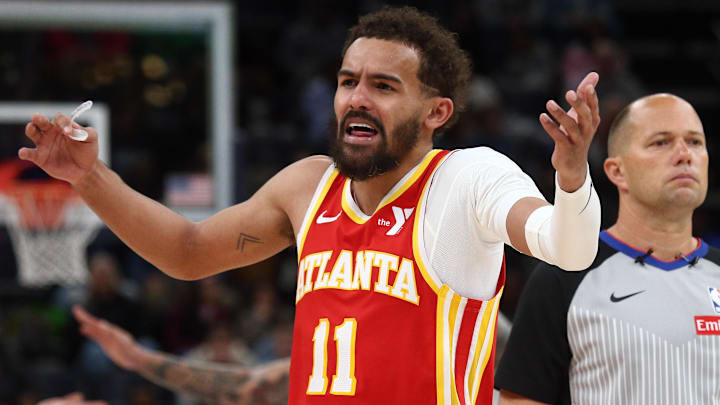A franchise point guard in his mid-20s, with almost a decade's worth of NBA experience, and only one season left on his current contract, just signed a four-year max extension that will pay him a projected $222.4 million through the 2029-30 campaign. It wasn’t Trae Young. It was De’Aaron Fox—a fellow floor general who, frankly, might not be as good.
There’s only one of two ways for the Atlanta Hawks to respond now: by maxing out Young themselves, or rolling the dice and waiting until next summer, when he holds a $49 million player option and could enter unrestricted free agency.
The De’Aaron Fox extension costs the Hawks leverage
Fox’s four-year agreement with the San Antonio Spurs is the same one Young can sign right now. Though it’s being reported as a $229 million extension, newer estimates have the league’s salary cap rising by only 7 percent in 2026-27, which would lower the value to $222.4 million.
Regardless, many consider maxing out Fox a caps-lock RISK for the Spurs. They have two other young guards on the roster, in Stephon Castle and Dylan Harper, neither of whom is a particularly intuitive fit alongside him. But San Antonio is stepping out on the limb anyway—betting that Fox will be worth this price point, or at the very least able to be traded while on this deal.
Atlanta has no choice other than to view Young’s value in those same terms. Many have wondered whether he could be forced to take less. After all, in the Era of Aprons, the bar for max contracts seems like it’ll inevitably be raised. Young’s negotiations loomed as an inflection point. He is a star, but not a consensus top-15 player. Would he be the first player of his ilk to let himself get squeezed, and to consign himself to a new reality?
It’s not happening. Or rather, the Hawks shouldn’t expect it to happen.
Young is, at minimum, on the same level as Fox. Over the past half-decade, he is averaging 26.5 points and 10.2 assists, with a 58.5 true shooting percentage. During this same span, Fox is putting up 24.3 points and 6.2 assists, on a 56.8 true shooting percentage. The defensive discrepancy has not been enough to prevent Young from posting generally higher catch-all-metric peaks, and though he’s criticized for his ball domination, his spot-up frequency last year (40.3 percent) wasn’t terribly lower than Fox’s (49.8 percent), according to BBall Index.
Hawks can’t afford to mess around with Trae Young
This no longer feels like a matter of debate. Young and his camp will point to Fox’s contract in negotiations, and it’s tough to argue that he should be paid less than his contemporary. If he offers to take a pay cut, or if he’s willing to sign a shorter deal that allows both sides to recalibrate in 2027 or 2028, then that’s one thing. But Atlanta risks creating a Micah Parsons trade demand situation if it’s not entirely in lockstep with its franchise cornerstone.
Oh, and by the way, Young’s cornerstone designation matters here, too. Fox just received the max, and he may not even be San Antonio’s second-most important player moving forward. No matter how high you are on the futures of Jalen Johnson and Zaccharie Risacher, the Hawks have yet to acquire someone who can reasonably supersede Young’s importance.
Combine all of this with the team not controlling its own first-rounder again until 2028, and Young officially has the leverage to command the full freight—if he didn’t already.
